Alina Miller jumped from a four-story building to escape a fire. Luckily she lived near the University of Colorado Hospital (UCH) Emergency Department, where experienced trauma doctors treated her injuries. With its years-long track record treating trauma patients, UCH in October 2018 earned a Level 1 trauma center designation for its combination of resources, research, and education.
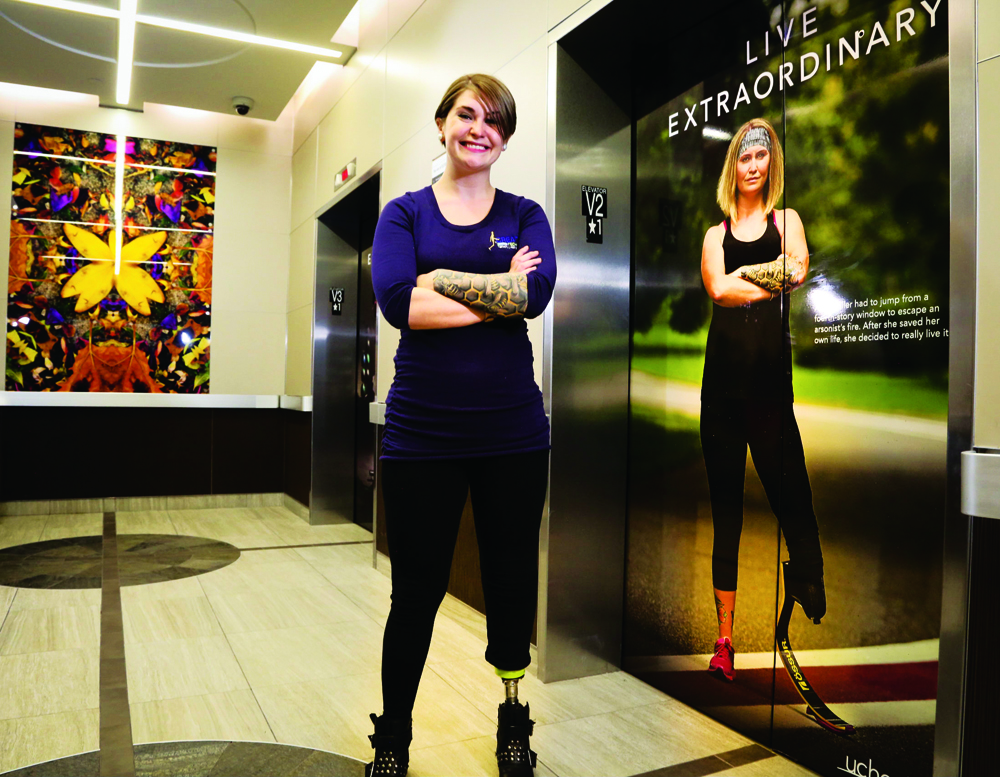
Alina Miller stands next to her life-sized image on a UCH hospital elevator door.
UCHealth Gains Level 1 Trauma Designation
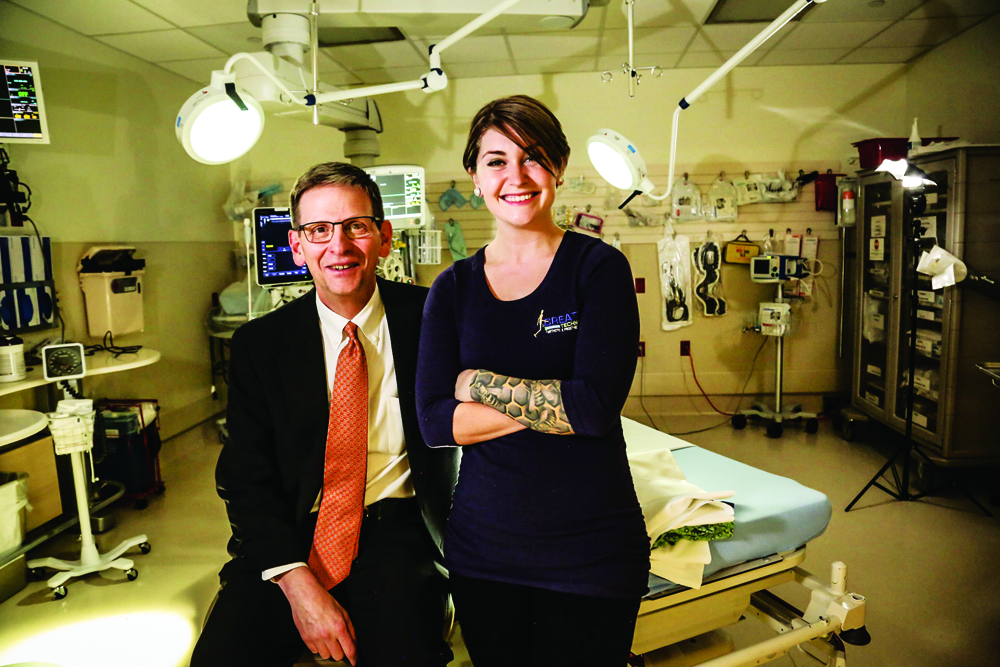
Fully recovered Alina Miller returned to the emergency room for a photo with Dr. Robert McIntyre, the hospital’s trauma medical director.
The first thing you notice about Alina Miller isn’t her colorful prosthesis, but her positivity. Even when she talks about the fire that impelled her to jump from her fourth-floor apartment, making her an amputee, she radiates joy as she says “It all happened perfectly.” She is not being ironic. Part of her good fortune in the face of adversity had to do with her apartment’s proximity to UCHealth University of Colorado Hospital (UCH), which in October 2018 received a Level 1 trauma center designation.
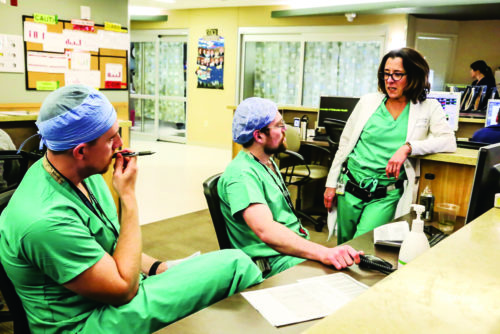
UCH emergency room resident physicians Tyler Downing (left) and Samuel Michel meet with attending physician Lisa Ferrigno during a pause in their work with patients.
The Colorado Department of Public Health and Environment (CDPHE) and American College of Surgeons announced the designation that makes UCH one of five such hospitals in the state, but as Miller attests, the designation largely recognizes the work that UCH had already been doing.
In 2012, when Miller was 22, an arsonist set fire to her apartment building at 17th and Peoria. She recalls being on the phone around 10:30pm when she noticed flames lighting her apartment orange from the burning apartment below hers. She tried to exit through the hallways but immediately recognized that the only way to survive the fire would be to go through a window. She couldn’t climb her way down the brick building as she had hoped, and plummeted to the ground. Landing on the concrete broke her back and shattered her feet. Overwhelmed with pain, her screams woke a second floor neighbor. When this resident escaped the building, she cradled Miller, comforting her as they helplessly watched the flames and smoke engulf the building.
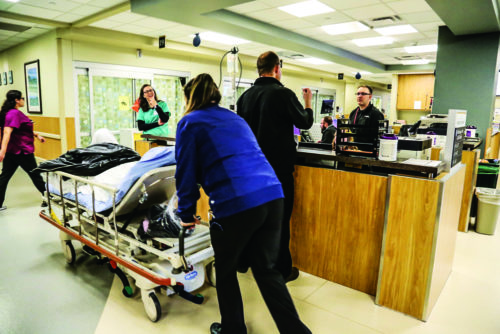
The UCH emergency room averages 275-300 patients a day. According to Dr. McIntyre, the trauma volume has increased 10% each year for the past four years.
She remembers being in the emergency room, and could feel the sense of urgency emanating from the doctors, nurses, and other staff. “But no one panicked,” she says. “Everybody was so clear with me and so wonderful. I felt they were like ‘We’ve got this. It’s going to be fine.’”
According to UCH, “Hospital trauma designations are determined according to established state and national criteria. Key elements required to be a Level I trauma center include around-the-clock coverage by trauma surgeons and prompt availability of the most comprehensive group of specialists in orthopedics, neurosurgery, and anesthesiology, among others. Such facilities also must be leaders in trauma prevention and education, conduct research, and meet volume requirements for treating severely injured patients.”
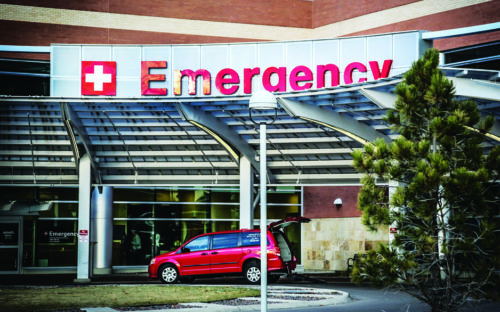
UCHealth Emergency Room entrance.
Dr. Robert McIntyre, the hospital’s trauma medical director and CU School of Medicine professor, adds that UCH’s volume of patient care has also increased by about 10% each year in the past four years. UCH sees between 275-300 patients a day coming through its emergency room. Many cases are the result of motor vehicle crashes, pedestrians or bicyclists hit by vehicles, falls, and penetrating trauma injuries such as gunshot wounds and stabbings. UCH also works with patients referred from hospitals in surrounding states, to ensure the highest level of care.
Miller underwent ten surgeries at UCH over the years. She worked closely with the medical team, and marveled at her doctors’ determination to save her foot despite the fact that it was smashed “like a potato chip” after the fall. Keeping her foot, however, proved to be more limiting to her mobility and her comfort.
She eventually decided to have her left leg amputated below the knee, and after returning from her honeymoon in Cancun, had the operation in January 2016. “It was the best decision I ever made.” Since the amputation, she has rock climbed, run a 5k, gone scuba diving, and embraced all the opportunities before her. Miller welcomes the questions that inevitably arise when strangers see her in her prosthetic, and views each encounter as an opportunity to reduce people’s fears and taboos around amputation and amputees. She encourages people not to avoid eye contact, but to engage with her and others who choose not to conceal their prosthetics. “I can do everything an able-bodied person can do,” she says. “I have a wonderful time being an amputee.”
The amputation resulted in a career shift for Miller, who now works for Creative Technology Orthotic and Prosthetic Solutions in Denver. She counsels patients in the months after amputation, to help them adjust to their new prosthetics. Occasionally, Dr. Robert Leland, her UCH orthopedic surgeon, asks her to meet with patients considering amputation.
It’s clear in speaking with Miller that the bonds she established at UCH are deep. The many doctors, surgeons, nurses, and others who cared for her—and continue to care for her—go “above and beyond,” she says.




0 Comments